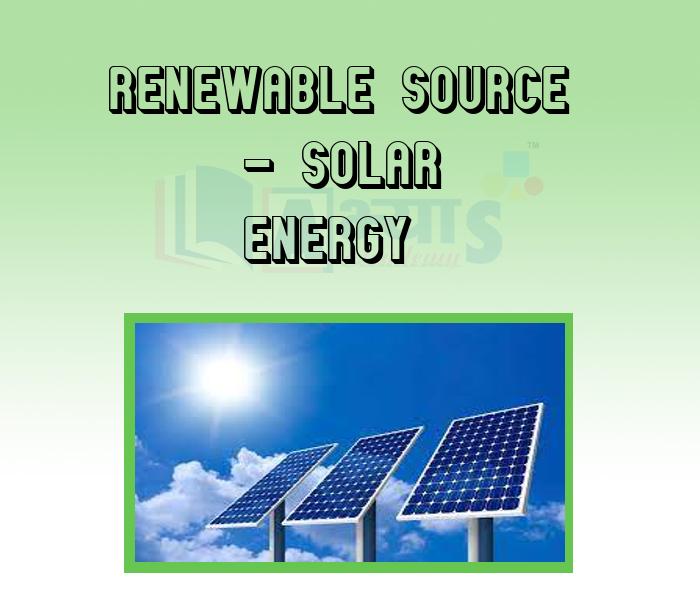Renewable Source - Solar Energy











Renewable Source - Solar Energy
Renewable Source - Solar Energy:
Solar Cells: Solar cell is a device that converts solar energy directly into electrical energy. Earlier, it was observed that when solar rays fall on a thin wafer of selenium, clectricity is generated. A solar cell made of selenium wafer converts only 0.7% of solar energy into electrical energy, which is very small output and hence impracticable for generating clectricity. The first solar cell made in 1954 could convert about 1% of incident solar energy into clectricity. Modern solar cells most commonly made from semi-metal silicon can have efficiency of up to 25%. Silicon is easily available and is eco-friendly. A typical solar cell consisting of a 2 x 2 cm square piece of pure silicon can produce about o.7 watt electricity with about 10% efficiency. This electricity is quite small and to get large amount of electricity several solar cells are connected together in series. This arrangemnent is called Solar Panel.
Advantages:
1. Solar cells provide eco-friendly environment.
2. Solar cells can be used anywhere as a self-generating source of electricity.
Limitations:
1. The availability of the special grade silicon required for making solar cells is very limited.
2. The cost of connecting material used in solar panels is very high as it is generally silver.
3. The current produced by solar cells is direct current (DC) and it has to be converted to alternating current (AC) for some devices. This involves high cost and loss of efficiency.
4. The conventional method of storing solar energy in storage batteries is not efficient enough.Uses:
1. In artificial sațellites
2. In radio wireless transmission
3. In TV transmission
4. In traffic signals and research centres
5. In calculators and watches
6. In solar cars
Students / Parents Reviews [10]
A marvelous experience with Abhyas. I am glad to share that my ward has achieved more than enough at the Ambala ABHYAS centre. Years have passed on and more and more he has gained. May the centre flourish and develop day by day by the grace of God.

Archit Segal
7thIt was a good experience with Abhyas Academy. I even faced problems in starting but slowly and steadily overcomed. Especially reasoning classes helped me a lot.

Cheshta
10thAbhyas is a complete education Institute. Here extreme care is taken by teacher with the help of regular exam. Extra classes also conducted by the institute, if the student is weak.

Om Umang
10thMy experience with Abhyas is very good. I have learnt many things here like vedic maths and reasoning also. Teachers here first take our doubts and then there are assignments to verify our weak points.

Shivam Rana
7thIt has a great methodology. Students here can get analysis to their test quickly.We can learn easily through PPTs and the testing methods are good. We know that where we have to practice

Barkha Arora
10thBeing a parent, I saw my daughter improvement in her studies by seeing a good result in all day to day compititive exam TMO, NSO, IEO etc and as well as studies. I have got a fruitful result from my daughter.

Prisha Gupta
8thOne of the best institutes to develope a child interest in studies.Provides SST and English knowledge also unlike other institutes. Teachers are co operative and friendly online tests andPPT develope practical knowledge also.

Aman Kumar Shrivastava
10thI have spent a wonderful time in Abhyas academy. It has made my reasoning more apt, English more stronger and Maths an interesting subject for me. It has given me a habbit of self studying

Yatharthi Sharma
10thIt was good as the experience because as we had come here we had been improved in a such envirnment created here.Extra is taught which is beneficial for future.

Eshan Arora
8thMy experience was very good with Abhyas academy. I am studying here from 6th class and I am satisfied by its results in my life. I improved a lot here ahead of school syllabus.
